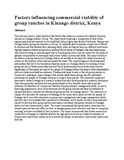| dc.description.abstract | This research project report looked at the factors that influence commercial viability of group ranches in Kinango district, Kenya. The report starts by giving a comparison of land tenure regimes and land use systems in the world and Africa region specifically California, Nigeria and Senegal before giving the situation in Kenya .In Califonia short extension courses were offered to ranchers and this boosted their planning skills, while in Nigeria there are different land tenure regimes based on historical and socio-political forces while in Senegal a fair land subdivision was achieved using an external agent and in Kenya group ranch concept carters for the needs of pastoral communities as communal land tenure system in semi arid lands.
The report looked at the failure of group ranches in Kinango district as not able to develop into viable commercial entities as the problem which had necessited the study. The report brings out the background information that led to the formation of group ranches in Kinango district by looking at three group ranches of Mwavumbo,Ndavaya and South Samburu,objectives of the study and the significance of this study not only to the people of Kinango district but also to other stakeholders such as scholars and land use planners. Fundamental issue to note is that all group ranches in Kenya have undergone major changes that include subdivision paving way for individual ownership yet people of Kinango continue to cling to this concept.
The researcher employed descriptive research design as a research method and used focus groups as a research instrument. Data was presented, analysed and interpreted based on five thematic areas which include, influence of education on commercial viability of group ranches, management skills, access to financing programmes, level of investments into the group ranches and how accessibility to markets influence commercial viability of group ranches in Kinango district.
The researcher in chapter five provides the summary of findings of the study which point out that the people of Kinango have very little education on group ranch management and range management skills and they have not exploited their proximity to Mombasa city to tap the lucrative meat and milk market to develop their group ranches and makes conclusion that group 'ranches in Kinango district are not commercially viable.
The report recommends that group ranch committees be trained upon election into office on how to manage group ranch resources and how to run group ranching activities on behalf of their members. The report recommends that further research be conducted in Kinango to establish whether the high poverty levels are related to adoption of Group ranch land tenure system so as to advise the people on alternative land tenure system and land use. | en_US |

